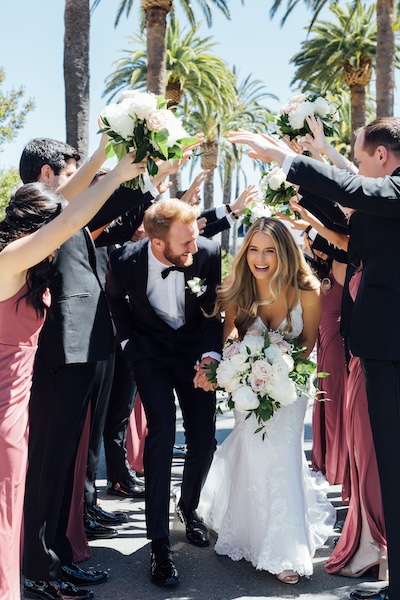Business + Marketing
We spent eight years living the ups and downs of being wedding photographers who hustled to make a living for our family, creating amazing photographs for our clients. From the first $300 paydays to the $6,000 luxury gigs, we had seen it all.
Along with the thrills, we also watched our four children grow up without us being there for many milestones. After 20-plus flights in 2015, we came home to our now teenagers who were participating in multiple sports in high school, realizing we had but a few years left to enjoy their presence in the home.
It was time for a change.

In-studio portraiture is still classic. Here, Ethan poses in a vintage chair on a handmade Silverlake backdrop. All photos © Jason Marino Photography
We had been doing portrait work here and there over the years, shooting the occasional boudoir, family or senior portrait session, but little did we know we could not only replace our wedding photography income by focusing on portraits, but we could absolutely crush that income. Here are the steps we took to get there.
1. Get a mentor!
Enter Steve Saporito, founder and owner of InTuition to Succeed. Steve’s name started appearing in Facebook groups, and from the mouths of friends such as the Chrismans, Mike Allebach, and the Ariases; people we admired and trusted. We decided to do some looking into what it was Steve was doing to transform the lives and businesses of our good friends, helping them to achieve incredible goals, and give their clients an experience like no other.
He taught us how to quote with confidence and make an emotional connection between our client and their images, all by getting deep into the love they share with their families.
2. Take a risk.
After months of research, we decided to hit Portland in late spring of 2016 for a week-long workshop with Steve. I quit my day job the following week. A month later, we replaced my annual income. The month after that, we replaced it again. And again. And again—all while photographing portraits of local families, from the comfort of our town. We were sleeping in our beds at night. No more hotels. No more airplanes. No more missing our children grow up. We were creating beautiful photographs of amazing people, and providing them with incredible artwork and albums to cherish forever.
Leaving the comfort of a day job can be terrifying, but if it’s planned correctly, it can be transformative. You must think about not only making money but having health insurance and the like. Make sure you have an income to live on for several months so that you can survive. Things went crazy for us really quickly—by implementing the lessons learned in Portland, we were able to immediately change our client experience. Right away, we stopped selling digital files and started educating our clients on the printed product. The results were immediate. Our first sale out of the gate was four figures. Within two sales, we were hitting $4,000 and up. By January, we had a $13,000 sale to one client.
3. Don’t shoot selfishly.
We’re used to looking for that epic, award-winning photo that will bring us fame, glory and millions of dollars (yeah, right!). Something we learned from Steve was that those photos were never the ones our clients had a connection to. Sure, they got a lot of Instagram likes and Facebook shares, but they didn’t have true meaning to those spending money with us. They chose the simple photo that portrayed their closeness, the real love and affection they have for themselves and their families. Once we realized that, we started focusing more on that and less on being “epic.”
This was a huge part of giving our clients the best experience possible. Suddenly, our sales got even better, and our referrals went up regardless of price. People craved that experience and wanted to share it.
4. Have pre-shoot consultations.
We learned that inviting clients to our studio is a great way to get them thinking about more than just digital files. We are able to not only walk them through the process of having a shoot done, but also show them samples of each item we offer. We let them hold albums, we have them walk through the space and see wall art, and we really immerse them in the idea of printed products. Also, show big or go home. People buy what you show. If you’re showing 8 x 10s, you will sell lots of 8 x 10s. If you’re showing 40 x 60 canvases, that’s what you’ll sell. Our studio is decked out in massive pieces of wall art, the smallest of which is 60 x 16. Guess what? We sell a lot of huge wall-art collections.
It’s natural for people to want to fit in, and showing our clients what is popular with other clients really helps them make decisions easier and helps us provide them with incredible artwork. We’ll say, “This 40 x 40 piece is popular with all of our seniors,” and Mom or Dad will nod their heads.
5. Follow up with post-shoot consults.
Many people bring in clients to show them their photos, but one thing we decided to do early on was to do so immediately following a shoot. The first thing we did was start “favoriting” the photos in camera as we shot. This saves us from having to cull the photos, which can take 10 minutes with a portrait session. We then started shooting in RAW+JPG, allowing us to grab the JPEG files and import them into our Fundy Software Suite without using software to convert the files first. This saves us several minutes as well, and doing both of these steps let’s you show a client their photos within minutes of a shoot.
Sitting clients down with some snacks and drinks, minutes after a shoot, really helps for a better experience and bigger sales. They can participate in creating an album and selecting wall art, and feel like they are a part of something big and important. It has been our most powerful tool for higher sales.
6. Price right for your brand.
We have high-end product pricing but keep one or two items around as objection handlers for clients who can’t afford the high-end products. We have a minimum order amount for each client and don’t offer sales or discounts to anyone. We confidently tell clients what an item costs, and we refuse to bargain on price, as it cheapens the experience. People don’t haggle with Hermès or Gucci. We want our clients to know our brand and experience is also to be respected. We have items ranging in price from $250 to $5,000.

Lots of seniors like to pose in their sports attire. Here, Becky reclines on a stairwell in an alley in downtown Kingman, Arizona.
7. Find the clients.
One might think being in a small town means there are a finite number of clients and opportunities, but we’ve found a way around that as well. Considering we have 30,000 people in our town, even 1 percent of them would keep us in business for well over a decade. And the opportunity to photograph families multiple times is always there. Maternity, newborn, first birthday, holidays, high school graduation, weddings—and the cycle repeats. We make clients for life and service them several times a year. If your town is only 10,000 people and if you can photograph just 1 percent of them annually, you’ll have a fantastic business.
We’ve created a marketing plan that continuously funnels clients to us. We have a private boudoir Facebook group, which has grown to 10,000 members. We market directly to families and seniors by photographing school and sports portraits. We also got permission from local high schools to bring posters and flyers in to promote directly to high school seniors. We run giveaways for each holiday on our Facebook page and do random giveaways of Starbucks cards and other fun items. They don’t cost us much and really drive a lot of traffic to our page.
It’s been about 20 months since we first made our transition. In that time, we’ve had ups and downs and growing pains like any business would. And we’re doing it all in a small town, a town we never thought could sustain our business. We decided to get our lives back and be present for our children and each other. In doing so, we were able to also meet incredible financial goals, far surpassing what we thought was ever possible.
We now have four employees, and we are charting a course for more growth. Through it all, we have honed our processes and continue to create beautiful art for our clients. That’s what matters to us.
Jason and JoAnne Marino, the owners of Imagine Photography, hail from the heart of Route 66 in Kingman, Arizona. Winners of numerous Fearless and ISPWP Awards and named 2015 Top 50 Wedding Photographers in America (Wedzilla) and 2017 Photographers of The Year (PhotoFinish), they are Interfit Photographic, MagMod and Fundy Software ambassadors.
Related: How One Midwestern Portrait Studio Increases Its Session Volume Yearly
How In-Person Sales Helped Me Work Less and Make More






